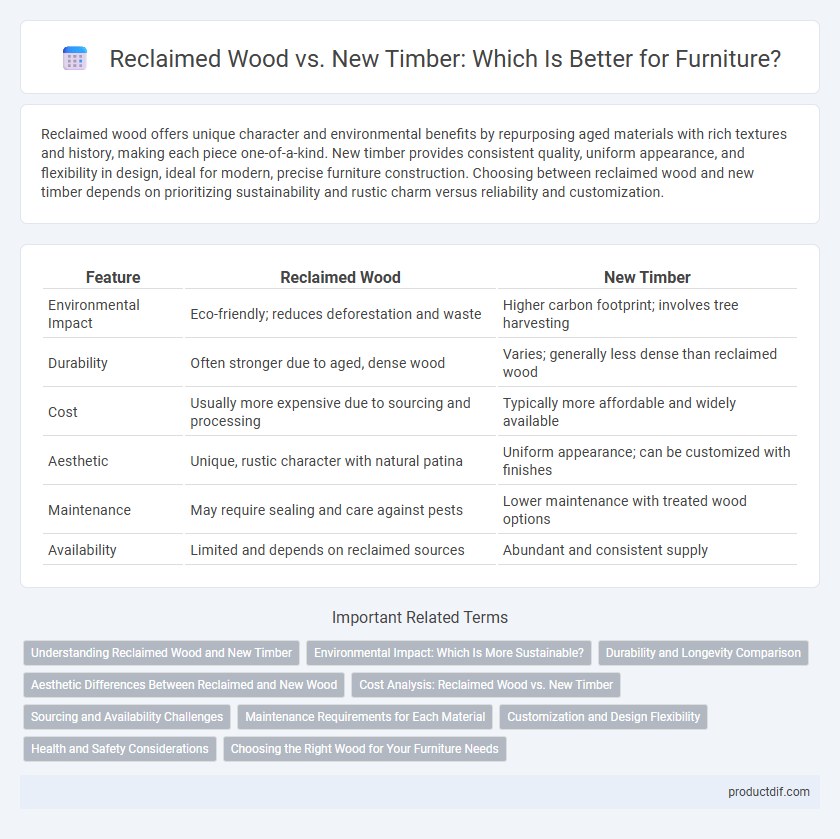Reclaimed wood offers unique character and environmental benefits by repurposing aged materials with rich textures and history, making each piece one-of-a-kind. New timber provides consistent quality, uniform appearance, and flexibility in design, ideal for modern, precise furniture construction. Choosing between reclaimed wood and new timber depends on prioritizing sustainability and rustic charm versus reliability and customization.
Table of Comparison
| Feature | Reclaimed Wood | New Timber |
|---|---|---|
| Environmental Impact | Eco-friendly; reduces deforestation and waste | Higher carbon footprint; involves tree harvesting |
| Durability | Often stronger due to aged, dense wood | Varies; generally less dense than reclaimed wood |
| Cost | Usually more expensive due to sourcing and processing | Typically more affordable and widely available |
| Aesthetic | Unique, rustic character with natural patina | Uniform appearance; can be customized with finishes |
| Maintenance | May require sealing and care against pests | Lower maintenance with treated wood options |
| Availability | Limited and depends on reclaimed sources | Abundant and consistent supply |
Understanding Reclaimed Wood and New Timber
Reclaimed wood is sourced from old structures such as barns, factories, and warehouses, offering unique character, durability, and environmental benefits by reducing demand for new logging. New timber comes directly from freshly cut trees and is prized for its uniformity, strength, and availability in a wide range of species and grades tailored to modern construction standards. Understanding the origins and properties of reclaimed wood versus new timber helps buyers choose materials that align with sustainability goals, aesthetic preferences, and specific furniture applications.
Environmental Impact: Which Is More Sustainable?
Reclaimed wood significantly reduces deforestation and landfill waste by repurposing existing materials, lowering the carbon footprint associated with timber harvesting and processing. New timber requires extensive resource consumption, including water, energy, and deforestation, contributing to habitat loss and increased greenhouse gas emissions. Sustainable forestry certifications like FSC can mitigate some impacts of new timber, but reclaimed wood remains the superior choice for minimizing environmental harm in furniture production.
Durability and Longevity Comparison
Reclaimed wood offers exceptional durability due to its age, dense grain, and prior exposure to environmental stress, often resulting in stronger, more stable furniture compared to new timber. New timber requires treatment and proper seasoning to achieve comparable longevity but can be more prone to warping or insect damage if improperly processed. Choosing reclaimed wood not only enhances lifespan but also provides unique character, making it a sustainable and resilient option in furniture manufacturing.
Aesthetic Differences Between Reclaimed and New Wood
Reclaimed wood features unique textures, weathered grains, and rich patinas developed over decades, offering a rustic, vintage aesthetic that adds character and history to furniture. New timber provides a cleaner, uniform appearance with smoother surfaces and consistent coloration, allowing for modern and polished design styles. The natural imperfections and color variations in reclaimed wood create a distinct, one-of-a-kind look compared to the more predictable, fresh finish of new wood.
Cost Analysis: Reclaimed Wood vs. New Timber
Reclaimed wood typically costs more upfront due to the labor-intensive process of sourcing, de-nailing, and restoring materials, but offers long-term savings through durability and unique character that can increase furniture value. New timber tends to be less expensive initially, benefiting from mass production and availability, yet may incur higher maintenance and replacement expenses over time due to susceptibility to wear and environmental damage. Evaluating cost-effectiveness requires balancing the premium price of reclaimed wood against its sustainability, lifespan, and potential resale value compared to fresh-cut lumber.
Sourcing and Availability Challenges
Reclaimed wood often presents sourcing challenges due to its limited and variable supply, requiring careful selection from demolition sites, old barns, or salvage yards to ensure quality and character. New timber is generally more readily available through commercial suppliers and managed forests, offering consistent dimensions and species options but raising concerns about sustainable harvesting practices. Both materials demand careful consideration of availability and environmental impact when choosing the right wood for furniture production.
Maintenance Requirements for Each Material
Reclaimed wood requires more frequent maintenance due to its age-related wear, often needing regular sealing and occasional sanding to preserve its character and prevent moisture damage. New timber demands less upkeep initially, benefiting from uniform quality and treated surfaces that resist pests and decay, but still requires annual inspections and refinishing to maintain durability. Both materials benefit from controlled indoor environments to extend their lifespan and minimize warping or cracking.
Customization and Design Flexibility
Reclaimed wood offers unique textures and patinas that enhance the character of custom furniture, providing design flexibility through its varied grain patterns and natural aging. New timber allows precise control over dimensions, species selection, and finishes, enabling tailored designs that meet specific aesthetic and structural requirements. Combining reclaimed and new wood can optimize customization by blending sustainability with modern design versatility.
Health and Safety Considerations
Reclaimed wood often contains old nails, screws, or chemical treatments that pose health and safety risks unless properly inspected and treated. New timber is typically free from contaminants, reducing the chance of allergic reactions, fungal growth, or exposure to harmful chemicals. Proper ventilation, sealing, and protective finishes are essential for both materials to ensure safe indoor air quality and prevent structural hazards.
Choosing the Right Wood for Your Furniture Needs
Reclaimed wood offers unique character and sustainability benefits by repurposing aged materials with rich textures and history, ideal for eco-conscious furniture makers. New timber provides consistent quality, uniformity, and easier customization, making it suitable for precise designs and modern finishes. Selecting the right wood depends on your project's aesthetic goals, environmental priorities, and the desired durability of the furniture piece.
Reclaimed Wood vs New Timber Infographic

 productdif.com
productdif.com